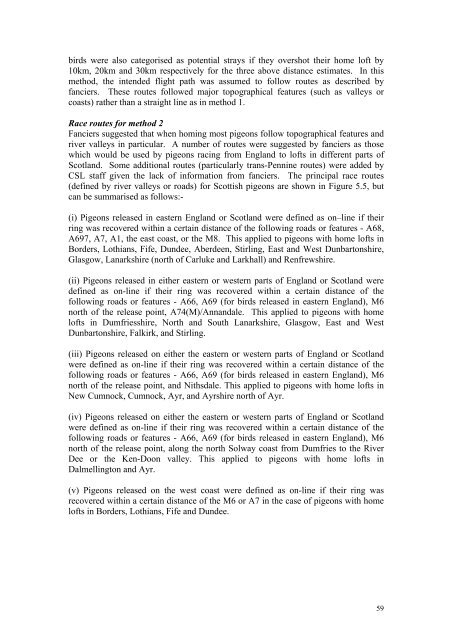RACING PIGEONS â IMPACT OF RAPTOR PREDATION
RACING PIGEONS â IMPACT OF RAPTOR PREDATION
RACING PIGEONS â IMPACT OF RAPTOR PREDATION
Create successful ePaper yourself
Turn your PDF publications into a flip-book with our unique Google optimized e-Paper software.
irds were also categorised as potential strays if they overshot their home loft by<br />
10km, 20km and 30km respectively for the three above distance estimates. In this<br />
method, the intended flight path was assumed to follow routes as described by<br />
fanciers. These routes followed major topographical features (such as valleys or<br />
coasts) rather than a straight line as in method 1.<br />
Race routes for method 2<br />
Fanciers suggested that when homing most pigeons follow topographical features and<br />
river valleys in particular. A number of routes were suggested by fanciers as those<br />
which would be used by pigeons racing from England to lofts in different parts of<br />
Scotland. Some additional routes (particularly trans-Pennine routes) were added by<br />
CSL staff given the lack of information from fanciers. The principal race routes<br />
(defined by river valleys or roads) for Scottish pigeons are shown in Figure 5.5, but<br />
can be summarised as follows:-<br />
(i) Pigeons released in eastern England or Scotland were defined as on–line if their<br />
ring was recovered within a certain distance of the following roads or features - A68,<br />
A697, A7, A1, the east coast, or the M8. This applied to pigeons with home lofts in<br />
Borders, Lothians, Fife, Dundee, Aberdeen, Stirling, East and West Dunbartonshire,<br />
Glasgow, Lanarkshire (north of Carluke and Larkhall) and Renfrewshire.<br />
(ii) Pigeons released in either eastern or western parts of England or Scotland were<br />
defined as on-line if their ring was recovered within a certain distance of the<br />
following roads or features - A66, A69 (for birds released in eastern England), M6<br />
north of the release point, A74(M)/Annandale. This applied to pigeons with home<br />
lofts in Dumfriesshire, North and South Lanarkshire, Glasgow, East and West<br />
Dunbartonshire, Falkirk, and Stirling.<br />
(iii) Pigeons released on either the eastern or western parts of England or Scotland<br />
were defined as on-line if their ring was recovered within a certain distance of the<br />
following roads or features - A66, A69 (for birds released in eastern England), M6<br />
north of the release point, and Nithsdale. This applied to pigeons with home lofts in<br />
New Cumnock, Cumnock, Ayr, and Ayrshire north of Ayr.<br />
(iv) Pigeons released on either the eastern or western parts of England or Scotland<br />
were defined as on-line if their ring was recovered within a certain distance of the<br />
following roads or features - A66, A69 (for birds released in eastern England), M6<br />
north of the release point, along the north Solway coast from Dumfries to the River<br />
Dee or the Ken-Doon valley. This applied to pigeons with home lofts in<br />
Dalmellington and Ayr.<br />
(v) Pigeons released on the west coast were defined as on-line if their ring was<br />
recovered within a certain distance of the M6 or A7 in the case of pigeons with home<br />
lofts in Borders, Lothians, Fife and Dundee.<br />
59
















